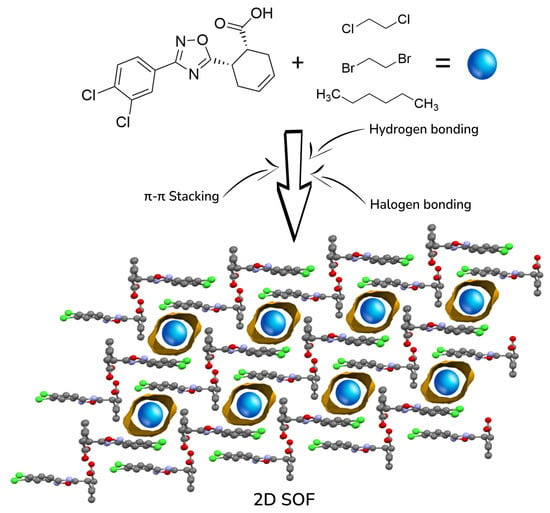Hybrid 2D Supramolecular Organic Frameworks (SOFs) Assembled by the Cooperative Action of Hydrogen and Halogen Bonding and π⋯π Stacking Interactions
Abstract
1. Introduction
2. Results and Discussion
2.1. The Hybrid 2D SOF Architectures
2.2. XB-Free Structure of trans-A
2.3. Theoretical Considerations
3. Material and Methods
3.1. Materials and Instruments
3.2. Synthetic Procedures
3.3. Crystal Growth and the XRD Studies
3.4. Computational Details
4. Conclusions
Supplementary Materials
Author Contributions
Funding
Institutional Review Board Statement
Informed Consent Statement
Data Availability Statement
Acknowledgments
Conflicts of Interest
References
- Freund, R.; Zaremba, O.; Arnauts, G.; Ameloot, R.; Skorupskii, G.; Dincă, M.; Bavykina, A.; Gascon, J.; Ejsmont, A.; Goscianska, J.; et al. The Current Status of MOF and COF Applications. Angew. Chem. Int. Ed. 2021, 60, 23975–24001. [Google Scholar] [CrossRef]
- Dhakshinamoorthy, A.; Li, Z.; Garcia, H. Catalysis and Photocatalysis by Metal Organic Frameworks. Chem. Soc. Rev. 2018, 47, 8134–8172. [Google Scholar] [CrossRef]
- Wang, Q.; Astruc, D. State of the Art and Prospects in Metal–Organic Framework (MOF)-Based and MOF-Derived Nanocatalysis. Chem. Rev. 2020, 120, 1438–1511. [Google Scholar] [CrossRef]
- Furukawa, H.; Gándara, F.; Zhang, Y.-B.; Jiang, J.; Queen, W.L.; Hudson, M.R.; Yaghi, O.M. Water Adsorption in Porous Metal–Organic Frameworks and Related Materials. J. Am. Chem. Soc. 2014, 136, 4369–4381. [Google Scholar] [CrossRef] [PubMed]
- Bazargan, M.; Ghaemi, F.; Amiri, A.; Mirzaei, M. Metal–Organic Framework-Based Sorbents in Analytical Sample Preparation. Coord. Chem. Rev. 2021, 445, 214107. [Google Scholar] [CrossRef]
- Yuan, S.; Li, X.; Zhu, J.; Zhang, G.; Van Puyvelde, P.; Van der Bruggen, B. Covalent Organic Frameworks for Membrane Separation. Chem. Soc. Rev. 2019, 48, 2665–2681. [Google Scholar] [CrossRef] [PubMed]
- Zhang, N.; Ishag, A.; Li, Y.; Wang, H.; Guo, H.; Mei, P.; Meng, Q.; Sun, Y. Recent Investigations and Progress in Environmental Remediation by Using Covalent Organic Framework-Based Adsorption Method: A Review. J. Clean. Prod. 2020, 277, 123360. [Google Scholar] [CrossRef]
- Mallakpour, S.; Nikkhoo, E.; Hussain, C.M. Application of MOF Materials as Drug Delivery Systems for Cancer Therapy and Dermal Treatment. Coord. Chem. Rev. 2022, 451, 214262. [Google Scholar] [CrossRef]
- Song, G.; Shi, Y.; Jiang, S.; Pang, H. Recent Progress in MOF-Derived Porous Materials as Electrodes for High-Performance Lithium-Ion Batteries. Adv. Funct. Mater. 2023, 33, 2303121. [Google Scholar] [CrossRef]
- Keller, N.; Bein, T. Optoelectronic Processes in Covalent Organic Frameworks. Chem. Soc. Rev. 2021, 50, 1813–1845. [Google Scholar] [CrossRef]
- Brammer, L.; Peuronen, A.; Roseveare, T.M. Halogen Bonds, Chalcogen Bonds, Pnictogen Bonds, Tetrel Bonds and Other σ-Hole Interactions: A Snapshot of Current Progress. Acta Crystallogr. Sect. C Struct. Chem. 2023, 79, 204–216. [Google Scholar] [CrossRef]
- Resnati, G.; Metrangolo, P. Celebrating 150 Years from Mendeleev: The Periodic Table of Chemical Interactions. Coord. Chem. Rev. 2020, 420, 213409. [Google Scholar] [CrossRef]
- Cornaton, Y.; Djukic, J.-P. Noncovalent Interactions in Organometallic Chemistry: From Cohesion to Reactivity, a New Chapter. Acc. Chem. Res. 2021, 54, 3828–3840. [Google Scholar] [CrossRef] [PubMed]
- Lin, R.-B.; Chen, B. Hydrogen-Bonded Organic Frameworks: Chemistry and Functions. Chem 2022, 8, 2114–2135. [Google Scholar] [CrossRef]
- Wang, B.; Lin, R.-B.; Zhang, Z.; Xiang, S.; Chen, B. Hydrogen-Bonded Organic Frameworks as a Tunable Platform for Functional Materials. J. Am. Chem. Soc. 2020, 142, 14399–14416. [Google Scholar] [CrossRef]
- Chu, J.; Liu, Z.; Yu, J.; Cheng, L.; Wang, H.; Cui, F.; Zhu, G. Boosting H + Storage in Aqueous Zinc Ion Batteries via Integrating Redox-Active Sites into Hydrogen-Bonded Organic Frameworks with Strong π-π Stacking. Angew. Chem. 2023, 136, e202314411. [Google Scholar] [CrossRef]
- Tang, J.; Yang, R.; Peng, Y.; Lin, H.; He, X.; Song, Y.; Wu, K.; Kang, Y.; Yang, L. Ultra-Thin Hydrogen-Organic-Framework (HOF) Nanosheets for Ultra-Stable Alkali Ions Battery Storage. Small 2023, 2307827. [Google Scholar] [CrossRef]
- Wang, Q.; Li, P.; Wen, H.-M.; Hu, K.-J.; Huang, Z.-Y.; Chen, J. A HOF-Based Electrochemical Aptasensor for Highly Sensitive and Selective Detection of Trace Oxytetracycline. Inorg. Chem. Commun. 2023, 156, 111213. [Google Scholar] [CrossRef]
- Cai, S.; An, Z.; Huang, W. Recent Advances in Luminescent Hydrogen-Bonded Organic Frameworks: Structures, Photophysical Properties, Applications. Adv. Funct. Mater. 2022, 32, 2207145. [Google Scholar] [CrossRef]
- Soleimani Abhari, P.; Gholizadeh, S.; Rouhani, F.; Li, Y.-L.; Morsali, A.; Liu, T.-F. Recent Progress in Gas Separation Platforms Based on Hydrogen-Bonded Organic Frameworks (HOFs). Inorg. Chem. Front. 2023, 10, 6134–6159. [Google Scholar] [CrossRef]
- Feng, L.; Yuan, Y.; Yan, B.; Feng, T.; Jian, Y.; Zhang, J.; Sun, W.; Lin, K.; Luo, G.; Wang, N. Halogen Hydrogen-Bonded Organic Framework (XHOF) Constructed by Singlet Open-Shell Diradical for Efficient Photoreduction of U(VI). Nat. Commun. 2022, 13, 1389. [Google Scholar] [CrossRef]
- Li, J.; Yin, Q.; Gao, S.-Y.; Feng, Y.; Ye, S.; Li, H.-F.; Cao, R. In Situ Self-Assembly of Hydrogen-Bonded Organic Frameworks for Organic Photoredox Catalysis. ACS Sustain. Chem. Eng. 2023, 11, 4389–4397. [Google Scholar] [CrossRef]
- Yu, D.; Zhang, H.; Ren, J.; Qu, X. Hydrogen-Bonded Organic Frameworks: New Horizons in Biomedical Applications. Chem. Soc. Rev. 2023, 52, 7504–7523. [Google Scholar] [CrossRef] [PubMed]
- González, L.; Graus, S.; Tejedor, R.M.; López, P.; Elguero, J.; Serrano, J.L.; Uriel, S. From Diiodo Tröger’s Bases towards Halogen-Bonded Porous Organic Crystalline Materials. CrystEngComm 2018, 20, 3167–3170. [Google Scholar] [CrossRef]
- Gong, G.; Lv, S.; Han, J.; Xie, F.; Li, Q.; Xia, N.; Zeng, W.; Chen, Y.; Wang, L.; Wang, J.; et al. Halogen-Bonded Organic Framework (XOF) Based on Iodonium-Bridged N⋅⋅⋅I+⋅⋅⋅N Interactions: A Type of Diphase Periodic Organic Network. Angew. Chem.-Int. Ed. 2021, 60, 14831–14835. [Google Scholar] [CrossRef]
- Shankar, S.; Chovnik, O.; Shimon, L.J.W.; Lahav, M.; Van Der Boom, M.E. Directed Molecular Structure Variations of Three-Dimensional Halogen-Bonded Organic Frameworks (XBOFs). Cryst. Growth Des. 2018, 18, 1967–1977. [Google Scholar] [CrossRef]
- Pop, L.; Grosu, I.G.; Miclǎuş, M.; Hǎdade, N.D.; Pop, A.; Bende, A.; Terec, A.; Barboiu, M.; Grosu, I. Halogen-Bonded Organic Frameworks of Perfluoroiodo- And Perfluorodiiodobenzene with 2,2′,7,7′-Tetrapyridyl-9,9′-Spirobifluorene. Cryst. Growth Des. 2021, 21, 1045–1054. [Google Scholar] [CrossRef]
- Gong, G.; Xie, F.; Wang, L.; Wang, J.; Chen, S. Construction and Characterization of a Diphase Two-Dimensional Halogen-Bonded Organic Framework Based on a Pyrene Derivative. Synlett 2023, 34, 423–428. [Google Scholar] [CrossRef]
- Soldatova, N.S.; Postnikov, P.S.; Ivanov, D.M.; Semyonov, O.V.; Kukurina, O.S.; Guselnikova, O.; Yamauchi, Y.; Wirth, T.; Zhdankin, V.V.; Yusubov, M.S.; et al. Zwitterionic Iodonium Species Afford Halogen Bond-Based Porous Organic Frameworks. Chem. Sci. 2022, 13, 5650–5658. [Google Scholar] [CrossRef]
- Gong, G.; Zhao, J.; Chen, Y.; Xie, F.; Lu, F.; Wang, J.; Wang, L.; Chen, S. An Amino-Type Halogen-Bonded Organic Framework for the Selective Adsorption of Aliphatic Acid Vapors: Insight into the Competitive Interactions of Halogen Bonds and Hydrogen Bonds. J. Mater. Chem. A 2022, 10, 10586–10592. [Google Scholar] [CrossRef]
- Gutzler, R.; Fu, C.; Dadvand, A.; Hua, Y.; MacLeod, J.M.; Rosei, F.; Perepichka, D.F. Halogen Bonds in 2D Supramolecular Self-Assembly of Organic Semiconductors. Nanoscale 2012, 4, 5965–5971. [Google Scholar] [CrossRef]
- Maji, S.; Natarajan, R. A Halogen-Bonded Organic Framework (XOF) Emissive Cocrystal for Acid Vapor and Explosive Sensing, and Iodine Capture. Small 2023, 19, 2302902. [Google Scholar] [CrossRef]
- Xia, N.; Han, J.; Xie, F.; Gong, G.; Wang, L.; Wang, J.; Chen, S. Construction of Halogen-Bonded Organic Frameworks (XOFs) as Novel Efficient Iodinating Agents. ACS Appl. Mater. Interfaces 2022, 14, 43621–43627. [Google Scholar] [CrossRef] [PubMed]
- Martí-Rujas, J.; Colombo, L.; Lü, J.; Dey, A.; Terraneo, G.; Metrangolo, P.; Pilati, T.; Resnati, G. Hydrogen and Halogen Bonding Drive the Orthogonal Self-Assembly of an Organic Framework Possessing 2D Channels. Chem. Commun. 2012, 48, 8207–8209. [Google Scholar] [CrossRef] [PubMed]
- Ji, B.; Zhang, D.; Liang, R.; Kang, G.; Zhu, Q.; Deng, D. Selective Binding and Removal of Aromatic Guests in a Porous Halogen-Bonded Organic Framework. Cryst. Growth Des. 2021, 21, 482–489. [Google Scholar] [CrossRef]
- Chongboriboon, N.; Samakun, K.; Inprasit, T.; Kielar, F.; Dungkaew, W.; Wong, L.W.Y.; Sung, H.H.Y.; Ninković, D.B.; Zarić, S.D.; Chainok, K. Two-Dimensional Halogen-Bonded Organic Frameworks Based on the Tetrabromobenzene-1,4-Dicarboxylic Acid Building Molecule. CrystEngComm 2019, 22, 24–34. [Google Scholar] [CrossRef]
- Zhou, Y.; Zhang, Y.-L.; Zhang, Q.; Yang, S.-Y.; Wei, X.-Q.; Tian, Z.; Shao, D. Supramolecular Porous Frameworks of Two Ni(II) Coordination Polymers with Varying Structures, Porosities, and Magnetic Properties. Polyhedron 2022, 225, 116078. [Google Scholar] [CrossRef]
- Yang, Z.; Saeki, A.; Inoue, A.; Oketani, R.; Kamiya, K.; Nakanishi, S.; Nakamura, T.; Hisaki, I. Slip-Stacking of Benzothiadiazole Can Provide a Robust Structural Motif for Porous Hydrogen-Bonded Organic Frameworks. Cryst. Growth Des. 2022, 22, 4472–4479. [Google Scholar] [CrossRef]
- Chen, T.-H.; Popov, I.; Kaveevivitchai, W.; Chuang, Y.-C.; Chen, Y.-S.; Daugulis, O.; Jacobson, A.J.; Miljanić, O.Š. Thermally Robust and Porous Noncovalent Organic Framework with High Affinity for Fluorocarbons and CFCs. Nat. Commun. 2014, 5, 5131. [Google Scholar] [CrossRef]
- Baykov, S.V.; Shetnev, A.A.; Semenov, A.V.; Baykova, S.O.; Boyarskiy, V.P. Room Temperature Synthesis of Bioactive 1,2,4-Oxadiazoles. Int. J. Mol. Sci. 2023, 24, 5406. [Google Scholar] [CrossRef]
- Baykov, S.; Semenov, A.; Tarasenko, M.; Boyarskiy, V.P. Application of Amidoximes for the Heterocycles Synthesis. Tetrahedron Lett. 2020, 61, 152403. [Google Scholar] [CrossRef]
- Semenov, A.V.; Baykov, S.V.; Soldatova, N.S.; Geyl, K.K.; Ivanov, D.M.; Frontera, A.; Boyarskiy, V.P.; Postnikov, P.S.; Kukushkin, V.Y. Noncovalent Chelation by Halogen Bonding in the Design of Metal-Containing Arrays: Assembly of Double σ-Hole Donating Halolium with CuI-Containing O,O-Donors. Inorg. Chem. 2023, 62, 6128–6137. [Google Scholar] [CrossRef] [PubMed]
- Baykov, S.; Mikherdov, A.; Novikov, A.; Geyl, K.; Tarasenko, M.; Gureev, M.; Boyarskiy, V. π–π Noncovalent Interaction Involving 1,2,4- and 1,3,4-Oxadiazole Systems: The Combined Experimental, Theoretical, and Database Study. Molecules 2021, 26, 5672. [Google Scholar] [CrossRef] [PubMed]
- Arunan, E.; Desiraju, G.R.; Klein, R.A.; Sadlej, J.; Scheiner, S.; Alkorta, I.; Clary, D.C.; Crabtree, R.H.; Dannenberg, J.J.; Hobza, P.; et al. Definition of the Hydrogen Bond (IUPAC Recommendations 2011). Pure Appl. Chem. 2011, 83, 1637–1641. [Google Scholar] [CrossRef]
- Bondi, A. Van Der Waals Volumes and Radii. J. Phys. Chem. 1964, 68, 441–451. [Google Scholar] [CrossRef]
- Desiraju, G.R.; Ho, P.S.; Kloo, L.; Legon, A.C.; Marquardt, R.; Metrangolo, P.; Politzer, P.; Resnati, G.; Rissanen, K. Definition of the Halogen Bond (IUPAC Recommendations 2013). Pure Appl. Chem. 2013, 85, 1711–1713. [Google Scholar] [CrossRef]
- Hachem, H.; Jeannin, O.; Fourmigué, M.; Barrière, F.; Lorcy, D. Halogen Bonded Metal Bis(Dithiolene) 2D Frameworks. CrystEngComm 2020, 22, 3579–3587. [Google Scholar] [CrossRef]
- Cheng, F.; Wang, H.; Hua, Y.; Cao, H.; Zhou, B.; Duan, J.; Jin, W. Halogen Bonded Supramolecular Porous Structures with a Kgm Layer. CrystEngComm 2016, 18, 9227–9230. [Google Scholar] [CrossRef]
- Malenov, D.P.; Zarić, S.D. Stacking Interactions of Aromatic Ligands in Transition Metal Complexes. Coord. Chem. Rev. 2020, 419, 213338. [Google Scholar] [CrossRef]
- Chen, T.; Li, M.; Liu, J. π–π Stacking Interaction: A Nondestructive and Facile Means in Material Engineering for Bioapplications. Cryst. Growth Des. 2018, 18, 2765–2783. [Google Scholar] [CrossRef]
- Yang, J.; Wang, J.; Hou, B.; Huang, X.; Wang, T.; Bao, Y.; Hao, H. Porous Hydrogen-Bonded Organic Frameworks (HOFs): From Design to Potential Applications. Chem. Eng. J. 2020, 399, 125873. [Google Scholar] [CrossRef]
- Cai, Y.; Gao, J.; Li, J.; Liu, P.; Zheng, Y.; Zhou, W.; Wu, H.; Li, L.; Lin, R.; Chen, B. Pore Modulation of Hydrogen-Bonded Organic Frameworks for Efficient Separation of Propylene. Angew. Chem. Int. Ed. 2023, 62, e202308579. [Google Scholar] [CrossRef] [PubMed]
- Yu, B.; Geng, S.; Wang, H.; Zhou, W.; Zhang, Z.; Chen, B.; Jiang, J. A Solid Transformation into Carboxyl Dimers Based on a Robust Hydrogen-Bonded Organic Framework for Propyne/Propylene Separation. Angew. Chem. Int. Ed. 2021, 60, 25942–25948. [Google Scholar] [CrossRef] [PubMed]
- Clark, T.; Hennemann, M.; Murray, J.S.; Politzer, P. Halogen Bonding: The σ-Hole. J. Mol. Model. 2007, 13, 291–296. [Google Scholar] [CrossRef] [PubMed]
- Bartashevich, E.V.; Tsirelson, V.G. Interplay between Non-Covalent Interactions in Complexes and Crystals with Halogen Bonds. Russ. Chem. Rev. 2014, 83, 1181–1203. [Google Scholar] [CrossRef]
- Shetnev, A.; Osipyan, A.; Baykov, S.; Sapegin, A.; Chirkova, Z.; Korsakov, M.; Petzer, A.; Engelbrecht, I.; Petzer, J.P. Novel Monoamine Oxidase Inhibitors Based on the Privileged 2-Imidazoline Molecular Framework. Bioorg. Med. Chem. Lett. 2019, 29, 40–46. [Google Scholar] [CrossRef]
- Baykov, S.V.; Tarasenko, M.V.; Semenov, A.V.; Katlenok, E.A.; Shetnev, A.A.; Boyarskiy, V.P. Dualism of 1,2,4-Oxadiazole Ring in Noncovalent Interactions with Carboxylic Group. J. Mol. Struct. 2022, 1262, 132974. [Google Scholar] [CrossRef]
- Baykov, S.; Tarasenko, M.; Zelenkov, L.E.; Kasatkina, S.; Savko, P.; Shetnev, A. Diastereoselective Opening of Bridged Anhydrides by Amidoximes Providing Access to 1,2,4-Oxadiazole/Norborna(e)Ne Hybrids. Eur. J. Org. Chem. 2019, 2019, 5685–5693. [Google Scholar] [CrossRef]
- Sheldrick, G.M. SHELXT—Integrated Space-Group and Crystal-Structure Determination. Acta Crystallogr. Sect. A Found. Adv. 2015, 71, 3–8. [Google Scholar] [CrossRef]
- Sheldrick, G.M. Crystal Structure Refinement with SHELXL. Acta Crystallogr. Sect. C Struct. Chem. 2015, 71, 3–8. [Google Scholar] [CrossRef]
- Dolomanov, O.V.; Bourhis, L.J.; Gildea, R.J.; Howard, J.A.K.; Puschmann, H. OLEX2: A Complete Structure Solution, Refinement and Analysis Program. J. Appl. Crystallogr. 2009, 42, 339–341. [Google Scholar] [CrossRef]
- Frisch, M.J.; Trucks, G.W.; Schlegel, H.B.; Scuseria, G.E.; Robb, M.A.; Cheeseman, J.R.; Scalmani, G.; Barone, V.; Petersson, G.A.; Nakatsuji, H.; et al. Gaussian 16, Revision C.01; Gaussian, Inc.: Wallingford, CT, USA, 2016. [Google Scholar]
- Adamo, C.; Barone, V. Toward Reliable Density Functional Methods without Adjustable Parameters: The PBE0 Model. J. Chem. Phys. 1999, 110, 6158–6170. [Google Scholar] [CrossRef]
- Grimme, S.; Antony, J.; Ehrlich, S.; Krieg, H. A Consistent and Accurate Ab Initio Parametrization of Density Functional Dispersion Correction (DFT-D) for the 94 Elements H-Pu. J. Chem. Phys. 2010, 132, 154104–154118. [Google Scholar] [CrossRef] [PubMed]
- Weigend, F. Accurate Coulomb-Fitting Basis Sets for H to Rn. Phys. Chem. Chem. Phys. 2006, 8, 1057–1065. [Google Scholar] [CrossRef] [PubMed]
- Bader, R.F.W. A Quantum Theory of Molecular Structure and Its Applications. Chem. Rev. 1991, 91, 893–928. [Google Scholar] [CrossRef]
- Bader, R.F.W. A Bond Path: A Universal Indicator of Bonded Interactions. J. Phys. Chem. A 1998, 102, 7314–7323. [Google Scholar] [CrossRef]
- Contreras-García, J.; Johnson, E.R.; Keinan, S.; Chaudret, R.; Piquemal, J.-P.; Beratan, D.N.; Yang, W. NCIPLOT: A Program for Plotting Noncovalent Interaction Regions. J. Chem. Theory Comput. 2011, 7, 625–632. [Google Scholar] [CrossRef]
- Todd, A.; Keith, T.K. Gristmill Software; AIMAll (Version 19.10.12); Overland Park, KS, USA. 2019. Available online: https://aim.tkgristmill.com (accessed on 8 January 2024).

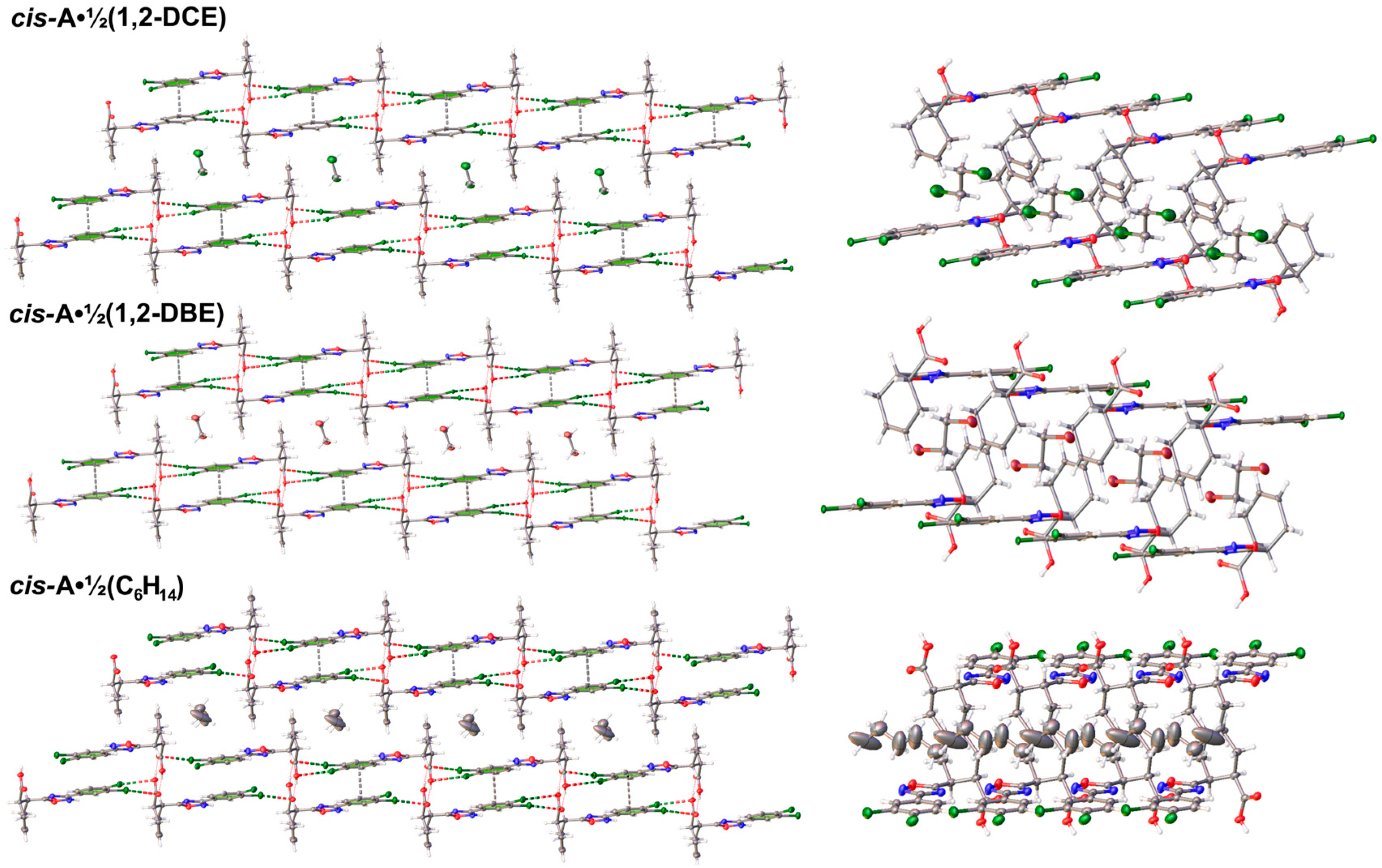
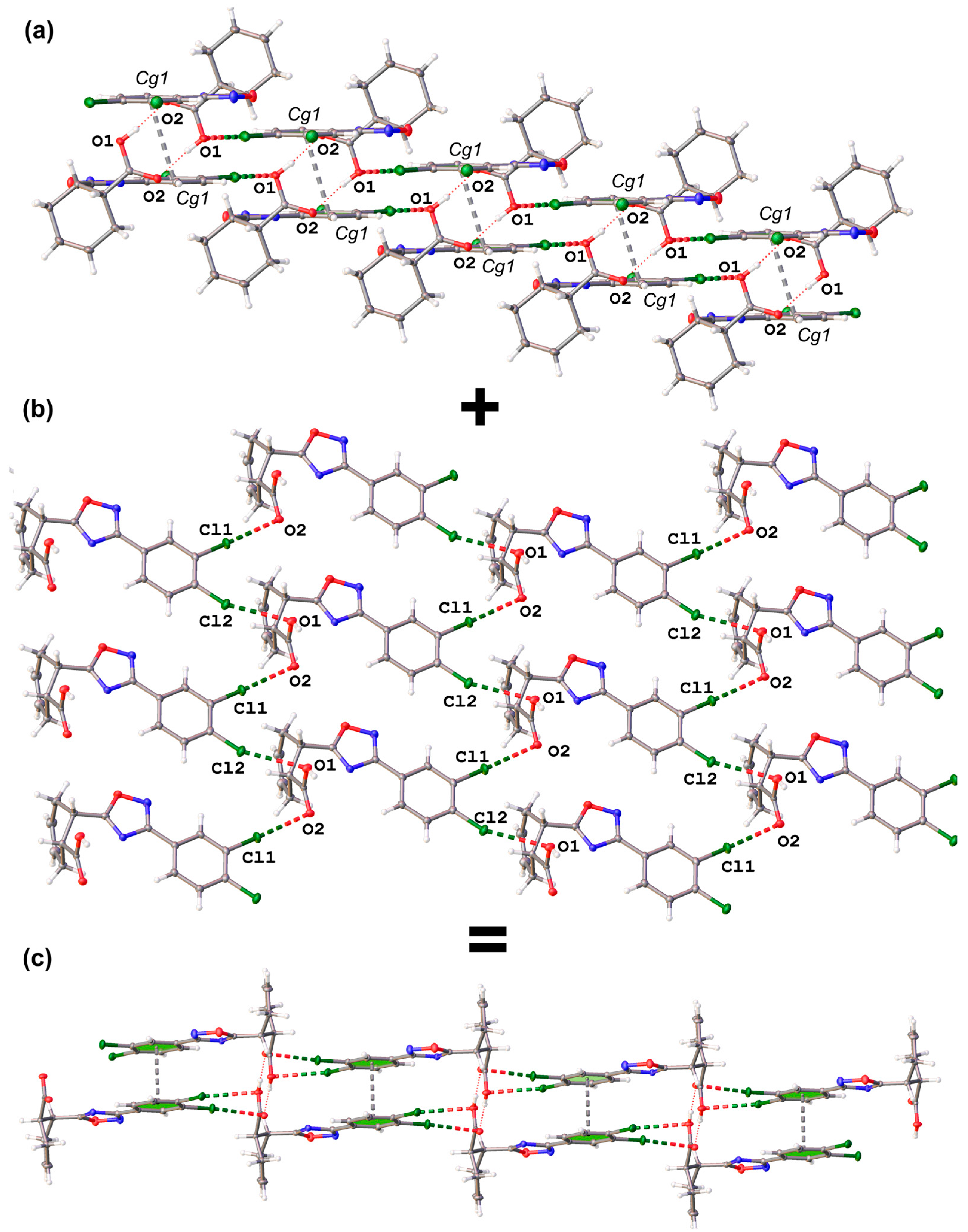
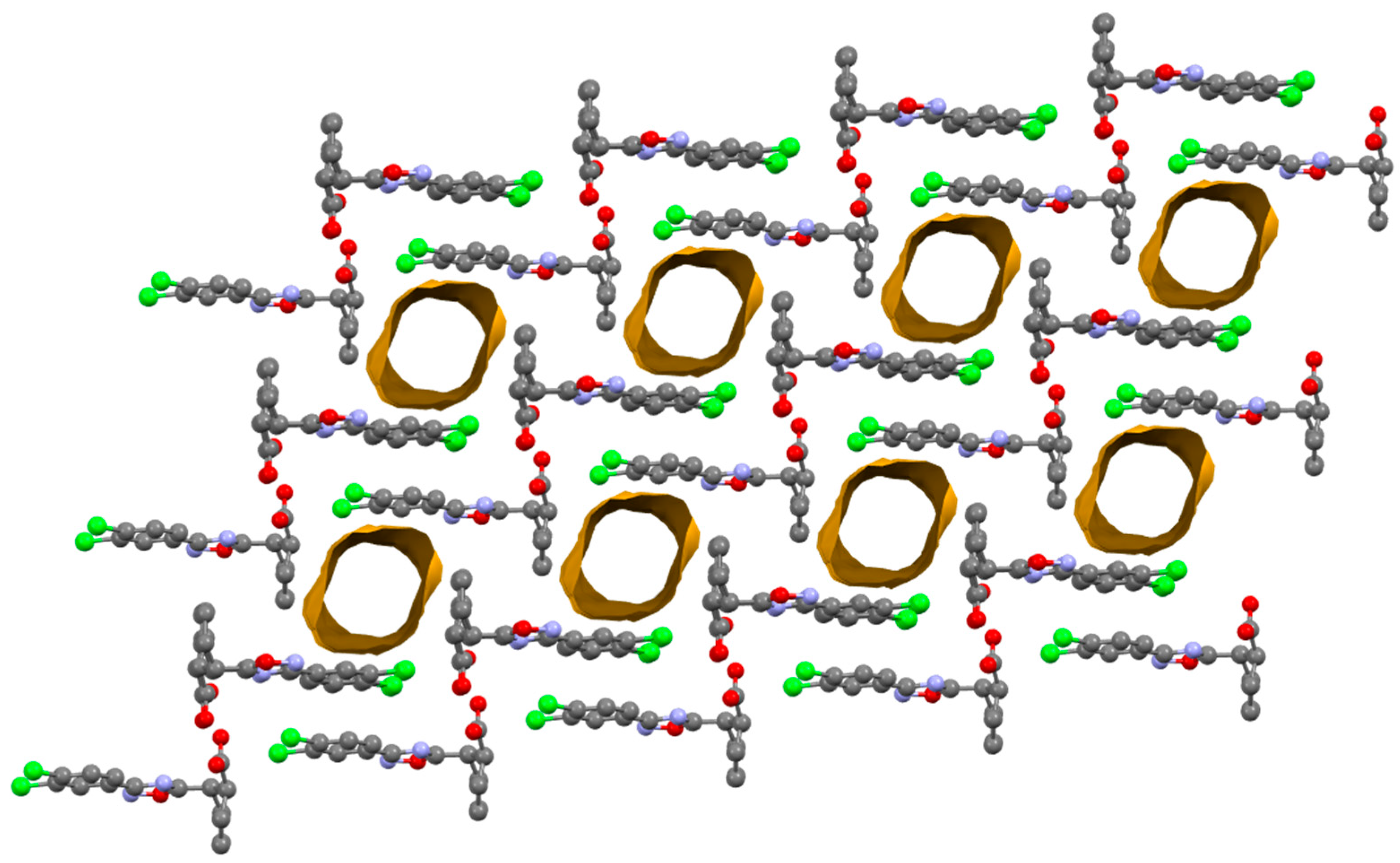
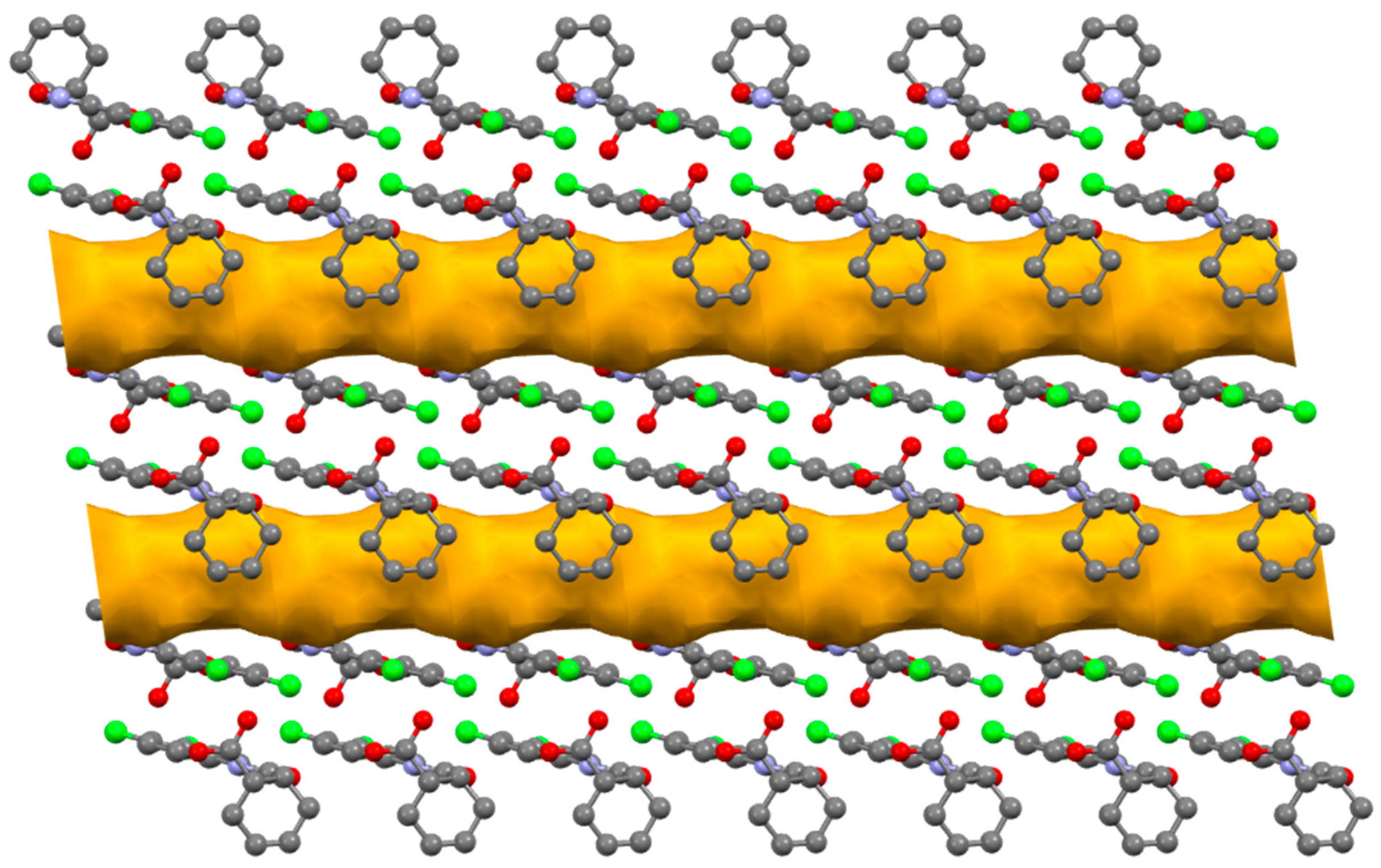
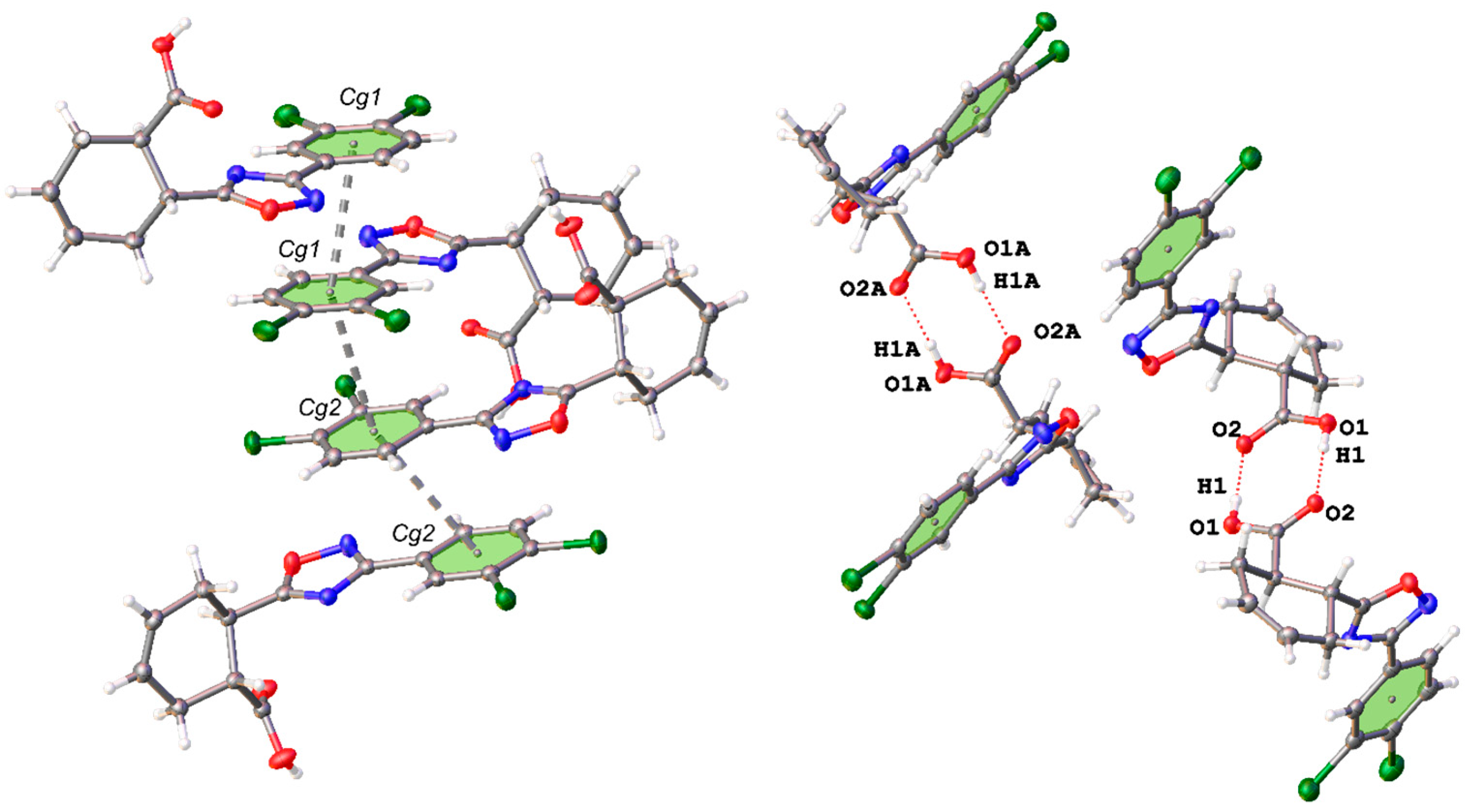
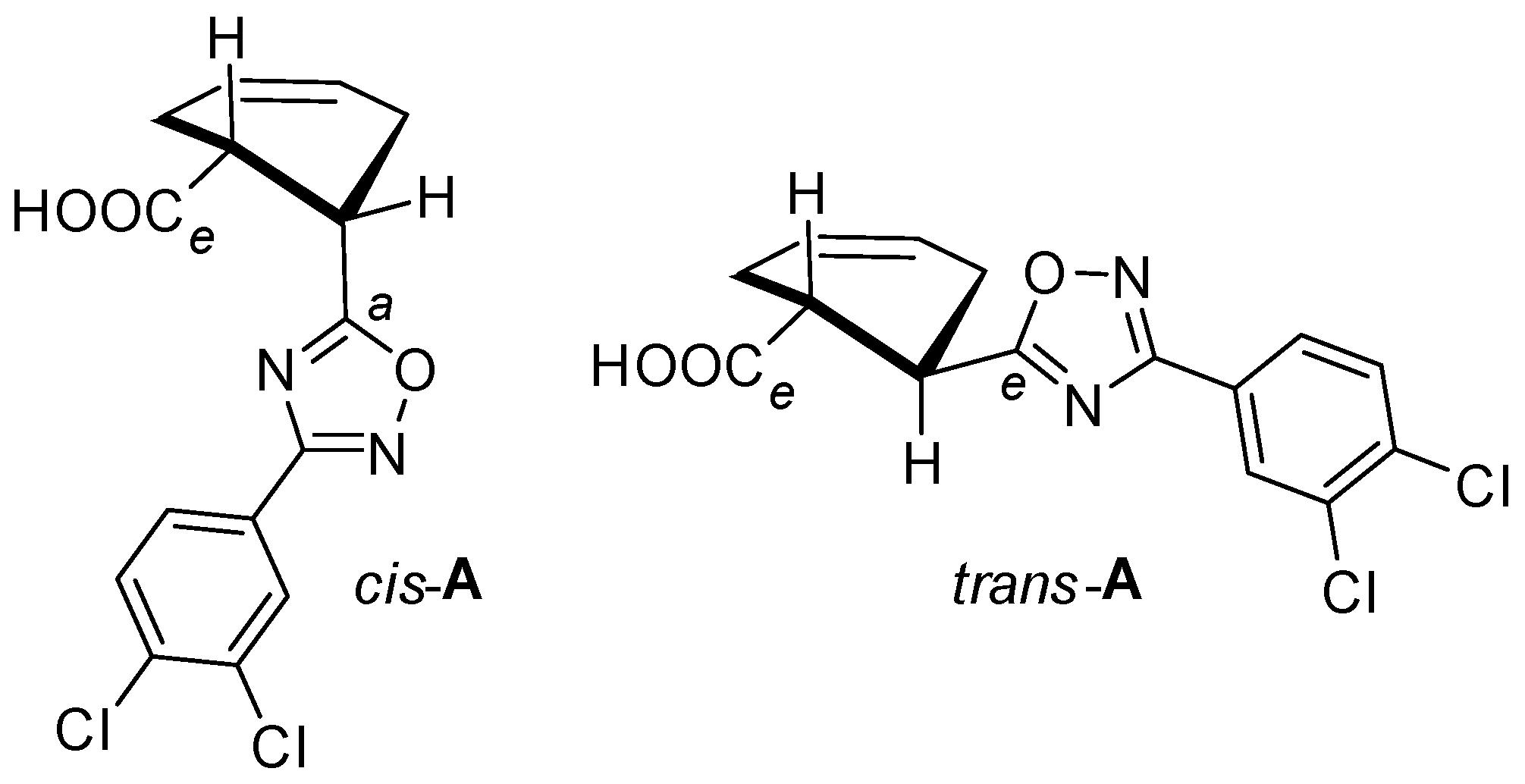
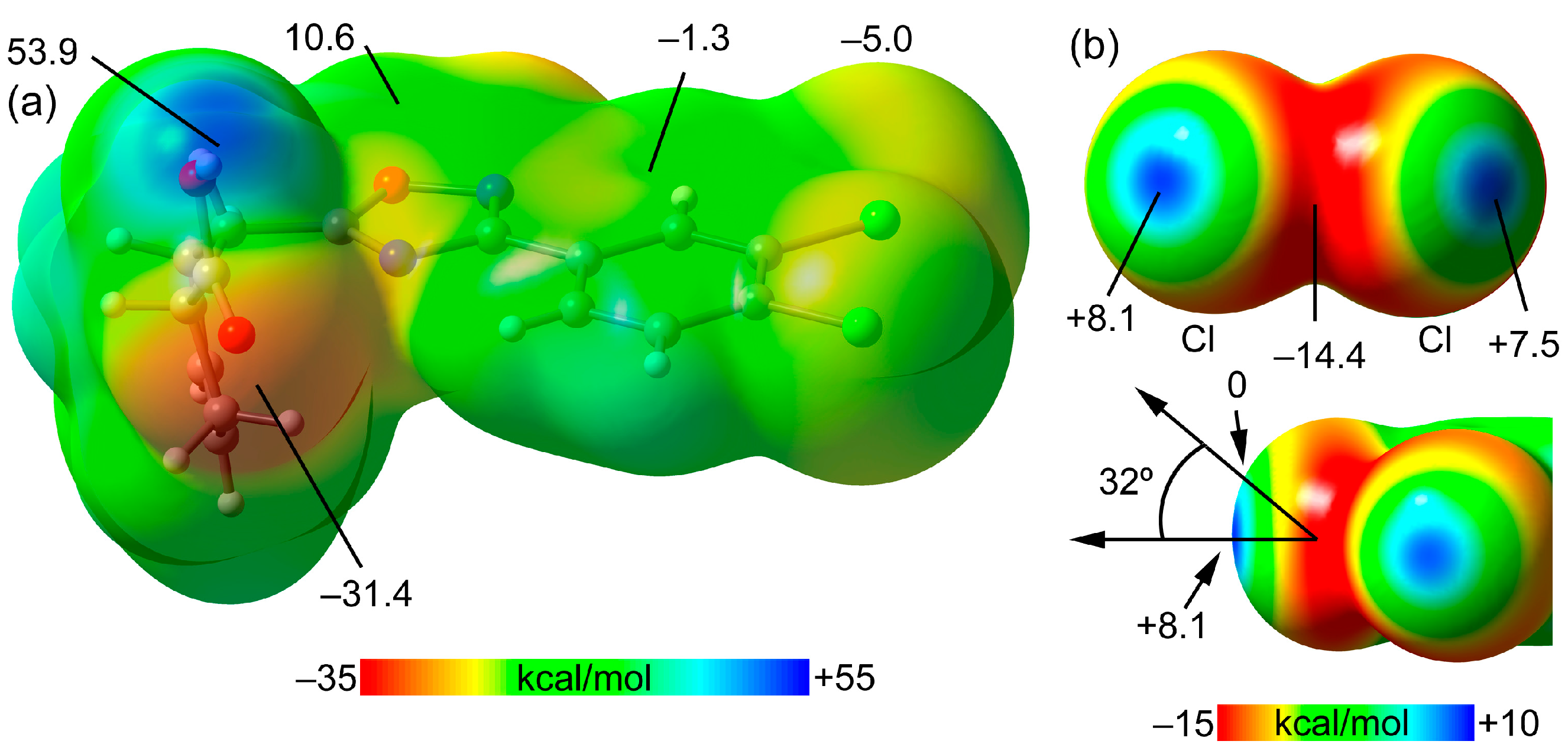
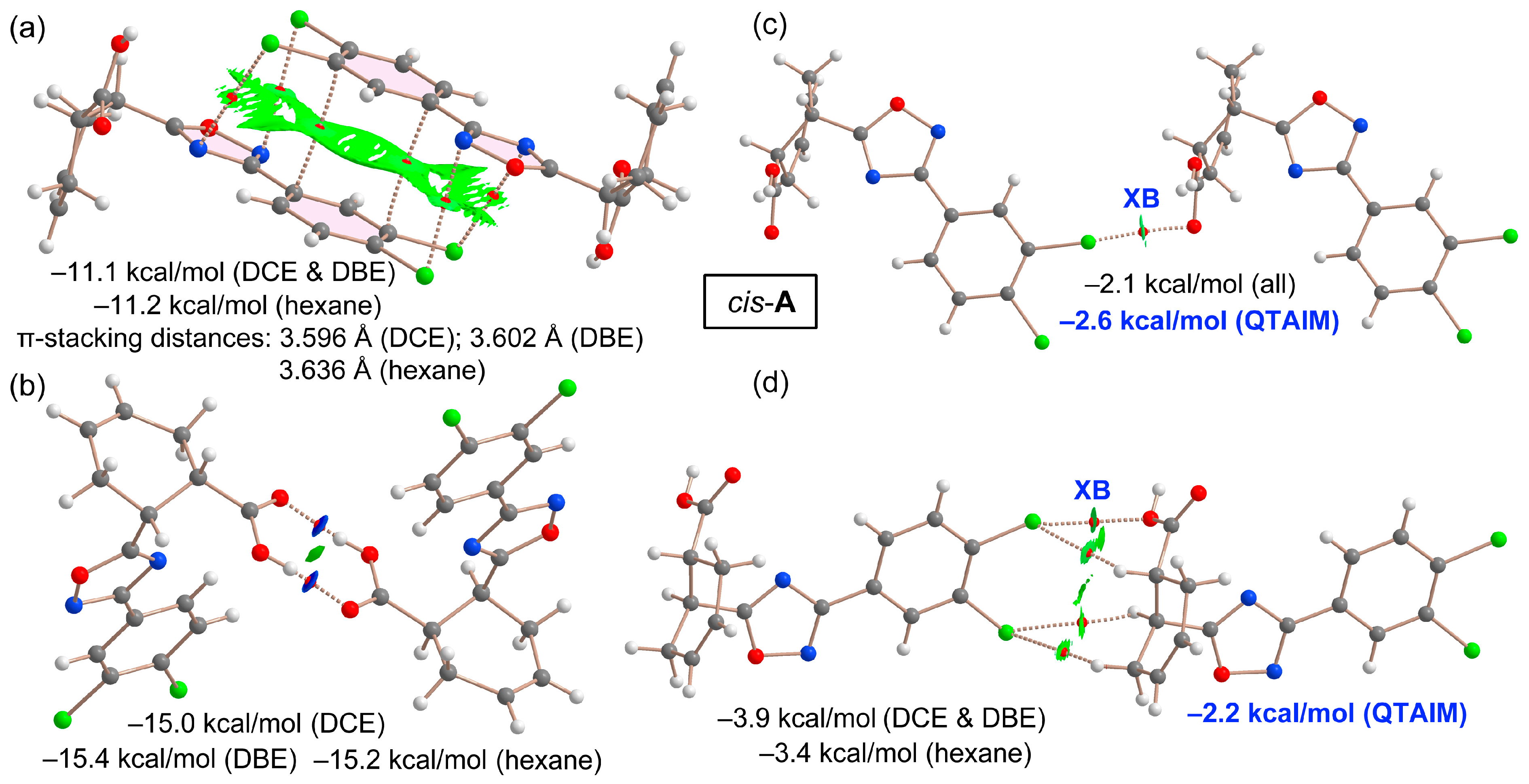
| Structure | Contact (Y–X⋯O) | d(Y–X⋯O), Å | ∠(Y–X⋯O), ° | R a |
|---|---|---|---|---|
| Hydrogen bonds | ||||
| cis-A‧½(1,2-DCE) | O1–H1⋯O2 | 1.7796(13) (2.6160(16)) b | 173.56(9) | 0.65 |
| cis-A‧½(1,2-DBE) | O1–H1⋯O2 | 1.784(2) (2.620(2)) b | 173.84(13) | 0.66 |
| cis-A‧½C6H14 | O1–H1⋯O2 | 1.7788 (2.616(2)) b | 172.81(14) | 0.65 |
| cis-A‧½(1,2-DCE) | O1–H1⋯O2 | 1.7796(13) (2.6160(16)) b | 173.56(9) | 0.65 |
| Halogen bonds | ||||
| cis-A‧½(1,2-DCE) | C12–Cl1⋯O2 | 3.0408(12) | 175.79(6) | 0.93 |
| C13–Cl2⋯O1 | 3.1820(13) | 157.27(6) | 0.97 | |
| cis-A‧½(1,2-DBE) | C12–Cl1⋯O2 | 3.0443(18) | 173.85(9) | 0.93 |
| C13–Cl2⋯O1 | 3.1701(19) | 157.39(10) | 0.97 | |
| cis-A‧½C6H14 | C12–Cl1⋯O2 | 3.0769(18) | 172.29(10) | 0.94 |
| C13–Cl2⋯O1 | 3.2172(19) | 156.55(10) | 0.98 | |
| π⋯π Stacking | ||||
| cis-A‧½(1,2-DCE) | Cg1⋯Cg1c | 3.5964(13) | ||
| cis-A‧½(1,2-DBE) | Cg1⋯Cg1c | 3.6015(19) | ||
| cis-A‧½C6H14 | Cg1⋯Cg1c | 3.636(2) | ||
Disclaimer/Publisher’s Note: The statements, opinions and data contained in all publications are solely those of the individual author(s) and contributor(s) and not of MDPI and/or the editor(s). MDPI and/or the editor(s) disclaim responsibility for any injury to people or property resulting from any ideas, methods, instructions or products referred to in the content. |
© 2024 by the authors. Licensee MDPI, Basel, Switzerland. This article is an open access article distributed under the terms and conditions of the Creative Commons Attribution (CC BY) license (https://creativecommons.org/licenses/by/4.0/).
Share and Cite
Baykov, S.V.; Semenov, A.V.; Presnukhina, S.I.; Tarasenko, M.V.; Shetnev, A.A.; Frontera, A.; Boyarskiy, V.P.; Kukushkin, V.Y. Hybrid 2D Supramolecular Organic Frameworks (SOFs) Assembled by the Cooperative Action of Hydrogen and Halogen Bonding and π⋯π Stacking Interactions. Int. J. Mol. Sci. 2024, 25, 2062. https://doi.org/10.3390/ijms25042062
Baykov SV, Semenov AV, Presnukhina SI, Tarasenko MV, Shetnev AA, Frontera A, Boyarskiy VP, Kukushkin VY. Hybrid 2D Supramolecular Organic Frameworks (SOFs) Assembled by the Cooperative Action of Hydrogen and Halogen Bonding and π⋯π Stacking Interactions. International Journal of Molecular Sciences. 2024; 25(4):2062. https://doi.org/10.3390/ijms25042062
Chicago/Turabian StyleBaykov, Sergey V., Artem V. Semenov, Sofia I. Presnukhina, Marina V. Tarasenko, Anton A. Shetnev, Antonio Frontera, Vadim P. Boyarskiy, and Vadim Yu. Kukushkin. 2024. "Hybrid 2D Supramolecular Organic Frameworks (SOFs) Assembled by the Cooperative Action of Hydrogen and Halogen Bonding and π⋯π Stacking Interactions" International Journal of Molecular Sciences 25, no. 4: 2062. https://doi.org/10.3390/ijms25042062
APA StyleBaykov, S. V., Semenov, A. V., Presnukhina, S. I., Tarasenko, M. V., Shetnev, A. A., Frontera, A., Boyarskiy, V. P., & Kukushkin, V. Y. (2024). Hybrid 2D Supramolecular Organic Frameworks (SOFs) Assembled by the Cooperative Action of Hydrogen and Halogen Bonding and π⋯π Stacking Interactions. International Journal of Molecular Sciences, 25(4), 2062. https://doi.org/10.3390/ijms25042062








